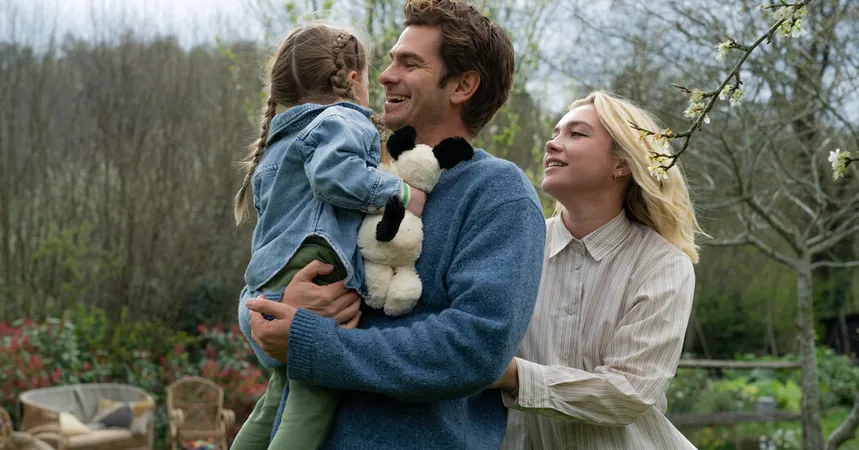
We Live in Time: A Timely Tear-Jerker That Will Leave You Breathless
2024-10-10
Author: Ting
Introduction
In the heart-wrenching film "We Live in Time," time is anything but static. This contemporary British drama, featuring an incredible performance by Florence Pugh as Almut and Andrew Garfield as Tobias, unfolds across several years, presenting a unique narrative structure that keeps viewers on the edge of their seats. Through a compelling blend of love, loss, and the complexities of life, this film takes us on an emotional rollercoaster that resonates deeply.
Plot Overview
The story deftly navigates the ups and downs of Almut and Tobias's relationship as they experience pivotal life moments — from passionate romances to the challenges of parenthood, all while confronting harsh realities. What sets this film apart is its non-linear approach to storytelling. The filmmakers ingeniously shuffle events from different time periods, allowing viewers to appreciate how shared memories and experiences intermingle to shape their relationship.
Cinematic Techniques
One particularly notable element of the film is its use of awakening scenes, linking various chapters of the couple’s lives—the bright mornings in their idyllic country home juxtaposed with the stark waking moments in their dark, bustling London flat. This clever device emphasizes not only their changing circumstances but also their enduring bond, making every moment rich with emotional significance.
Character Development
Written by Nick Payne and directed by John Crowley, "We Live in Time" traverses three distinct periods of the couple's lives — spanning years, months, and even a single day. While the transition between these timelines can be abrupt—initially leaving audiences feeling a bit disoriented—the film employs tangible markers: characters' evolving haircuts and the physical growth of their daughter, Ella (portrayed by Grace Delaney), grounding the viewer in this intricate tapestry of time.
Themes of Resilience
As the plot unravels, it becomes clear that Almut’s journey is marked by significant personal growth, particularly in her culinary career. She evolves from working in a quaint restaurant to managing her own Michelin-starred establishment, showcasing her ambition and talent. However, her journey is met with heartbreaking twists — the return of her ovarian cancer sends shockwaves through her life, adding emotional depth to her character. This pivotal moment serves as a reminder of life’s cruel unpredictability.
Performance Highlights
Pugh's performance as Almut shines with vibrancy, bringing clarity and grit to a character burdened with both ambition and uncertainty. Her struggles represent a broader commentary on women’s ambitions and the challenges they face in society. Yet, as the narrative unfolds, it appears to overshadow her accomplishments, reducing Almut to a tragic figure battling her circumstances.
Conclusion
The film resonates with themes of resilience and heartbreak, making a poignant statement about life's ephemeral nature and the heavy toll that challenges can take on personal identity. Observing Almut's battles reminds one of the stark realities many women face, and how, even in the glimmering light of success, there can be shadows lurking just out of view.
"We Live in Time" is a mixture of love, tragedy, and growth that strikes a chord with anyone who has ever navigated life's complexities. Rated R for its sensitive depiction of relationship dynamics and health struggles, this remarkable film is a visual and emotional experience that runs for 1 hour and 47 minutes.
If you’re looking for a heartfelt cinematic experience that explores the depths of human connection and the intricacies of time, look no further — this film will undoubtedly leave you in contemplative silence long after the credits roll. Don't miss your chance to witness a story that is both timeless and deeply relatable!


 Brasil (PT)
Brasil (PT)
 Canada (EN)
Canada (EN)
 Chile (ES)
Chile (ES)
 España (ES)
España (ES)
 France (FR)
France (FR)
 Hong Kong (EN)
Hong Kong (EN)
 Italia (IT)
Italia (IT)
 日本 (JA)
日本 (JA)
 Magyarország (HU)
Magyarország (HU)
 Norge (NO)
Norge (NO)
 Polska (PL)
Polska (PL)
 Schweiz (DE)
Schweiz (DE)
 Singapore (EN)
Singapore (EN)
 Sverige (SV)
Sverige (SV)
 Suomi (FI)
Suomi (FI)
 Türkiye (TR)
Türkiye (TR)